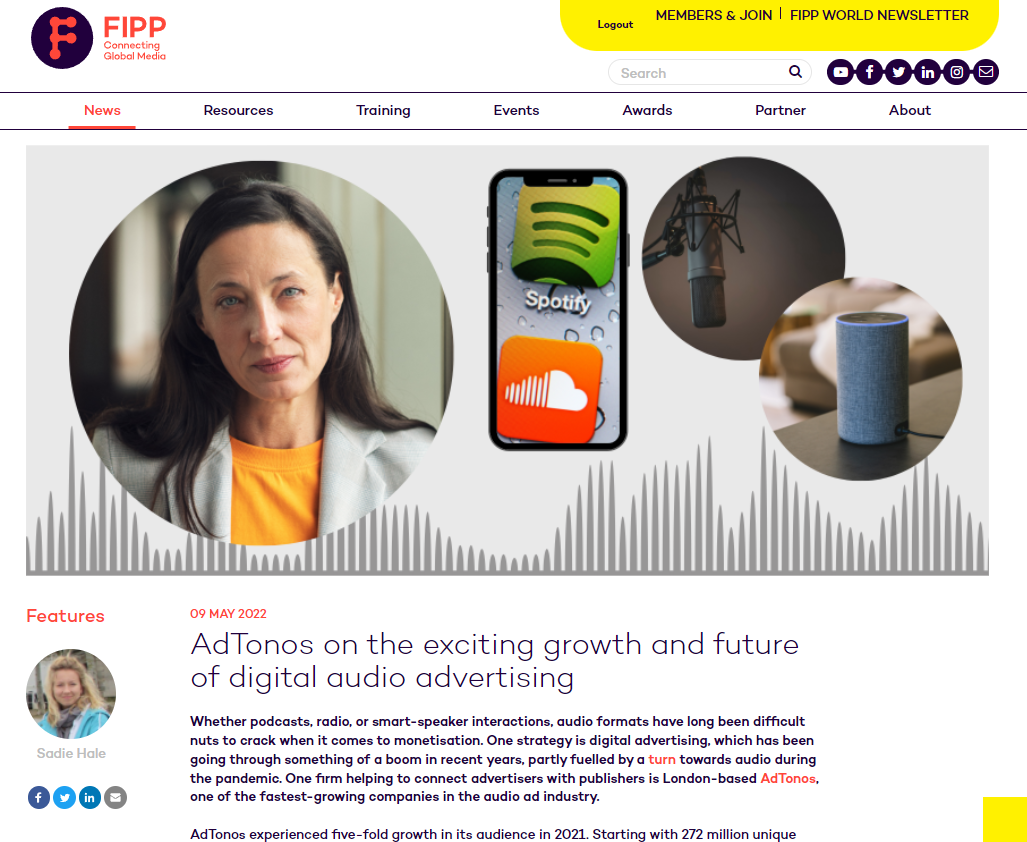AdTonos experienced five-fold growth in its audience in 2021. Starting with 272 million unique listeners, and serving over three billion audio ads monthly, it now has a global reach of 1.5 billion unique listeners and serves over five billion ads every month.
As more niches emerge in the audio space, growth opportunities will come thick and fast. FIPP spoke to Katarzyna Bargielska, CMO and co-founder, to learn more about the technology that drives this success, growth areas to watch out for, why she expects even greater success in the coming year, and much more.

Please introduce us to the company, how it came about, the services you provide and your role within the company.
AdTonos is a London-based digital audio advertising company. We are an audio-centric company that successfully monetises podcasts, audiobooks, gaming, music, and radio streams across Europe, LATAM and the US. AdTonos is the first company in the world to bring real-time interactivity to live radio. Our YoursTruly technology allows advertisers to dynamically insert interactive ads in live radio content and works on any Alexa enabled devices.
While the idea behind AdTonos was born a long time ago, it wasn’t until 2017 that founder Michal Marcinik took the prototype of the ad replacement technology to the RadioDays conference in Amsterdam. This was a time period with lots of activity: Michal took part in RadioHack and won first place and made it to the finals (amongst nearly 500 start-ups!) of the InCredibles accelerator programme launched by billionaire Sebastian Kulczyk and received a grant for $50k which enabled us to finish the prototype.
In 2018 Michal Marcinik invited myself and Wojciech Lichota to join him as co-founders. My full role is CMO & Co-founder. I manage all marketing and PR activities across different channels worldwide, while Wojtek Lichota is CTO & Co-founder.
Can you explain how it works – give us a technical breakdown of the platform? How you work with advertisers vs how you work with publishers?
The Adtonos marketplace connects advertisers with publishers, offering multiple audio ad placements from well-known pre-rolls through to mid-rolls and real-time ad replacement for live streaming – this is what we are most known for.
How does it work?


The AdTonos platform is a Demand Side Platform (DSP) that allows advertisers to reach premium audio inventory at the best price for any audio media: podcasts, audiobooks, mobile gaming, radio, and music streams, through either direct media buying or programmatic.
Our SaaS platform is integrated with more than 21 DSPs and collaborates with some of the largest media buyers worldwide – which assures the best offers – and allows advertiser and sales teams to work with either direct self-service or a sales dashboard.
Once you have an account on our platform and your audio slot has been prepared, you can upload it and set up your campaign parameters – all of which can take as little as 10 minutes! The campaign order is then generated automatically and broadcast upon payment.
The audio industry is definitely beginning to experience a boom in development.
AdTonos also provides innovative tools to measure the results and effectiveness of every audio campaign and every played ad. We share two types of reports: one from the campaign launch, and from Audiopixel™. Our reports offer a range of traffic tracking options, including conversion calculation on the advertiser’s website and measurement and post-campaign analytics that help our advertisers achieve better results and optimise spend.
The statistics on the advertiser’s dashboard are available from the moment the first playouts are broadcast, and we can measure the web traffic generated from ads we play via Audiopixel. Audiopixel can be easily integrated with Google Analytics or Google Tag Manager for remarketing or performance tracking, and provides great insight into campaign performance, unique listeners, and integration with Google Analytics IDs.
We also have a Supply Side Platform (SSP) that allows publishers to integrate their inventory with the best DSPs, monetising audio streams across all devices: desktop, mobile, and smart speakers. There are three types of integration possible: VAST, ad replacement and Playlist. Alongside this, we have also launched the Sandstorm SDK for mobile gaming publishers.
Audio ads are more personal and engaging, they help build a direct relationship between the brand and the recipient, and since audio content is already verified by the publisher that broadcasts it, is an inherently brand safe environment.
The industry has talked a lot about podcasts for many years now, and I feel like we’re just starting to see some momentum with them and other forms of audio – like audio listening options on the top of standard editorial articles. So how important is it that we have effective, structured monetisation strategies for these forms of media?
This is a very important question for all sides of the market, both advertisers and publishers. The audio industry is definitely beginning to experience a boom in development, similar to display advertising and other forms of Internet advertising a few years ago.
One of the most important things to consider is how media consumption is changing in developed countries, as audiences are increasingly using mobile devices and smart speakers, as well as listening to an increasing variety of different audio formats, from digital radio to streaming music, audiobooks and podcasts.
Furthermore, by using our DSP, advertisers have tools to measure the effects of audio campaigns, similar to those available for other forms of Internet advertising, at their disposal. Audio ads are more personal and engaging, they help build a direct relationship between the brand and the recipient, and since audio content is already verified by the publisher that broadcasts it, is an inherently brand safe environment.
According to the latest Standards Media Index (US), while both digital audio and broadcast radio have both seen double-digit growth during the past year, the rate of digital advertising spending increased is triple that of radio, and is now approaching parity with broadcast radio in terms of national ad dollar, and digital audio ads have risen rapidly from a 24% share of national audio ad spend in 2017 to 49% in 2021.
As opposed to visual formats, audio advertising cannot be skipped (from ad block for example), so audio is becoming an increasingly attractive channel for advertisers, although not all marketers have noticed this yet.
And this is without even going into the potential associated with cars and voice interfaces, m-commerce, and the possibilities of voice interface-enhanced retail and e-commerce development – this huge topic would need its own separate article.
I saw a recent post on your site about navigating the post-cookie era. This is – as you would imagine – also a big topic for our members right now. Could you please talk to me a little bit about that and how AdTonos fits into the post-cookie solution?
In general, the entire advertising market is faced with the question of a post-cookie world. However, the advertising industry is very creative and innovative, and I am convinced that it will solve the data problem for digital advertising campaigns. Certainly everyone, including our platform, will put more emphasis on the use of First Party Data, but we will also be focusing on other solutions as well.
We are, for example, conducting talks with strategic partners in order to obtain data for our clients’ campaigns, but it’s too early to talk about this in more detail. Of course, we will definitely announce any important developments to the market.
“As opposed to visual formats, audio advertising cannot be skipped (from ad block for example), so audio is becoming an increasingly attractive channel for advertisers.”
And are there other important areas of audio that the industry should be paying close attention to right now?
Definitely – but I’ll try to keep it short! For a long time, audio advertising has, for the most part, been associated with advertising on traditional radio. Advertisers did not consider it a worthy investment and often underestimated the power of audio.
Now the industry is booming and developing at a dizzying pace. Looking only at our platform, our reach quintupled last year, and so far, the growth at the beginning of 2022 has been even faster in terms of unique listeners. It won’t surprise me if it turns out that by the end of the year we will have experienced a 10-time audience increase.
In my opinion, audio is only just the beginning. My passion in the area of audio advertising involves voice interfaces and what they can offer advertisers in the future field of interactive advertising, such as our YoursTruly technology, or the entire e-commerce reformatting.
More specifically, I would say real-time interaction such as through smart-speakers, as well as targeting actively involved mobile gamers through intermission and reward ads are definitely spaces to watch for the audio advertising community. AdTonos will have some big announcements to make in these areas very soon.



